Scotch Macaskill's Wildlife Blog
IMPORTANT: Please note that from April 2009 this Blog's Web address changed as a result of a switch in the blogging platform we use. It's still an integral part of the Wildlife Pictures Online website and, we hope, will continue providing entertaining and enjoyable content in the form of wildlife images, news, views and information.
For the most recent posts, links, and other resources, please visit the new Wldlife Photography Blog.
|
New article about abandoned pet monkeys
September 12, 2006
|
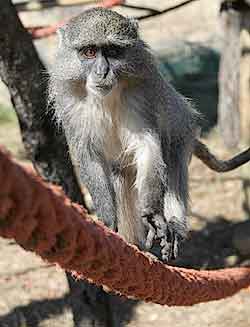 This young samango monkey is destined to spend its life walking along and swinging from man-made ropes rather than natural branches and vines.
This young samango monkey is destined to spend its life walking along and swinging from man-made ropes rather than natural branches and vines.
It's another victim of human thoughtlessness, in which people think they can keep monkeys as pets because they're "cute" - until something happens and the monkey is regarded as a "problem" animal.
Near my home town there is a small wildlife sanctuary where abandoned monkeys are cared for by wildlife film-maker Victor Hugo. But it's already too late to re-introduce them to the wild. Read the full article - A Life Behind Bars for "Pet" Monkeys - to find out more.
|
Today's picture: Lion cub
September 12, 2006
|
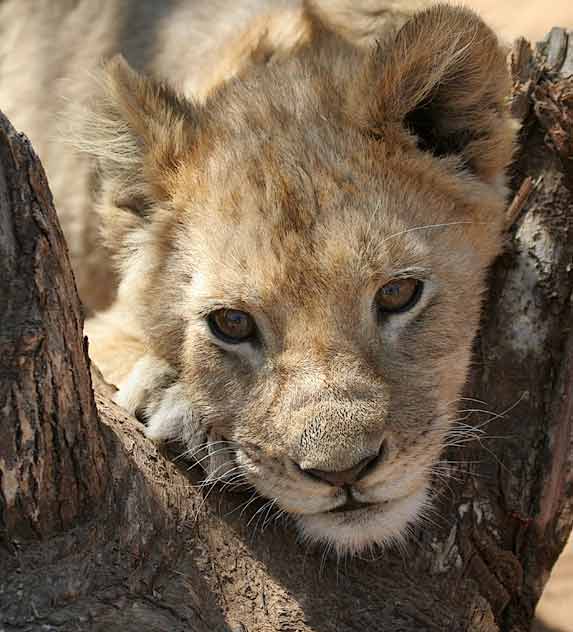
Photo Details: Lion cub (Panthera leo) resting its head on tree stump, Sondéla Wildlife Centre, Limpopo Province, South Africa.
Camera: Canon EOS 350D; Lens: Canon 100-400 IS Zoom; Focal Length: 100mm; Shutter speed: 1/800; Aperture: f5; ISO: 400
Additional Info: Sondéla Wildlife Centre, an animal hospital within the Sondela Nature Reserve, was established to assist in the care and treatment of animals affected by the recent increase in tourism and game farming in Limpopo Province, South Africa.
Game numbers have increased drastically in the area as more and more landowners have converted cattle farms into private nature reserves. This in turn has led to an increase in the capture and relocation of wild animals. Unfortunately, as in all capture operations, animals do get injured and have to be treated accordingly.
The burgeoning wildlife population has also meant more animal babies being rescued and nurtured prior to being released back into the wild.
Sondéla Wildlife Centre, with dedicated and trained staff, is able to offer specialist care for animals in need, providing an essential service to private landowners, wildlife veterinarians and game capture operators.
The lion cub in the photo above is one of a litter of four being cared for at Sondéla prior to being returned to the wild.
About two months old, the cubs are still like cuddly, playful kittens, only their massive paws and occasional growls warning you that they're not like your average tabby cat.
|
Today's picture: Caracal
September 13, 2006
|
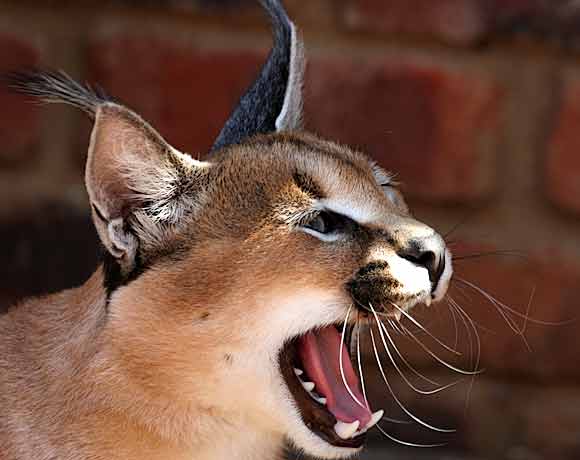
Photo Details: Young Caracal (Felis caracal) showing off its fine teeth and long whiskers, Sondéla Wildlife Centre, Limpopo Province, South Africa.
Camera: Canon EOS 350D; Lens: Canon 100-400 IS Zoom; Focal Length: 250mm; Shutter speed: 1/200; Aperture: f5; ISO: 400
Additional Info: This young caracal, raised at the Sondéla Wildlife Centre, is soon to be released back into the wild. Although it purred like a domestic cat when we entered its enclosure, clearly enjoying the human company, the vet we spoke to at the centre assured us that wild cats have little problem fending for themselves once released.
Caracals can vary in color from silvery grey to sandy brown, with pure white underparts, but it's their high, black-backed ears tipped with tassles of longer hair that are their most characteristic feature.
An adult male weighs around 17kg (38lbs), standing about 40-45 cm (17") at the shoulder. Caracals are very solidly built and strong for their size, allowing them to take sheep, goats and small antelope as prey, while their long back legs give them excellent jumping powers.
Because caracals are nocturnal and secretive, they are seldom sighted during the day in game parks and nature reserves.
|
Today's Picture: Kudu Bull
September 15, 2006
|
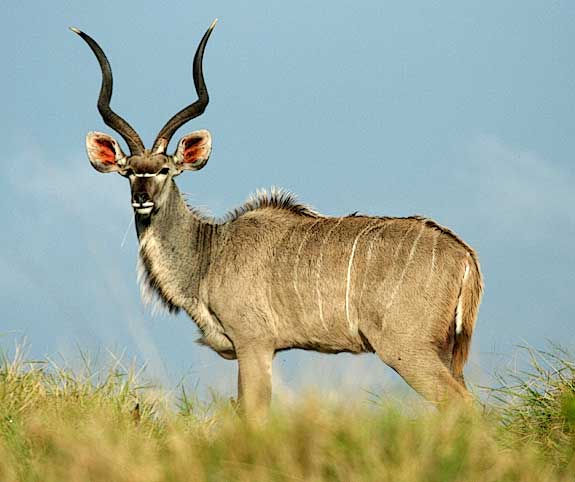
Photo Details: Kudu bull (Tragelaphus strepsiceros) against skyline, Greater St Lucia Wetland Park, KwaZulu-Natal, South Africa.
Camera: Canon EOS 350D; Lens: Canon 100-400 IS Zoom; Focal Length: 320mm; Shutter speed: 1/2000; Aperture: f5.6; ISO: 400
Additional Info: The Greater St Lucia Wetland Park, an aggregation of marine, wetland and savannah habitats, was declared a World Heritage Site in late 1999.
The park, which stretches along the northern section of South Africa's east coast from Mapelane in the south to Sodwana in the north, includes forests, wetlands, mangroves and vegetated dunes, superb beaches and coral reefs.
This astonishing diversity supports an abundance of Nile crocodile and hippo, as well as rhino (both black and white), elephant, buffalo, giraffe, waterbuck, kudu, nyala, impala, duiker and reedbuck, plus numerous bird species. It is also of regional importance for duck and other water bird populations which are able to survive in the region when there are severe droughts elsewhere in southern Africa.
The greater St Lucia system comprises five recognizable ecosystems:
- Lake St Lucia – the largest estuarine system on the African continent. The lake, averaging only one meter in depth, is home to more than a thousand hippos, several thousand crocodiles, 526 birds, and 114 species of fish.
- Eastern shores (Dune & Forests) – inland and east of lake St Lucia, consisting of grassy plains, wetlands and ancient coastal dune forests that grow on the towering sand dunes. The dunes form a natural barrier between the lake, rivers and the Indian ocean.
- The marine system – east of the park, covering 280km of Indian ocean coastline and the adjacent marine eco system. The endangered leatherback turtles swim thousand of sea miles, to return to their place of birth, to lay eggs along this stretch of coast.
- Mkuze swamps – northern end of lake St Lucia, includes papyrus wetland
- Western shores – savanna and thornveld, making up the the driest area and home to many of the mammals such as elephant, buffalo, rhino and various antelope species.
|
Today's Picture: Rising Moon
September 18, 2006
|
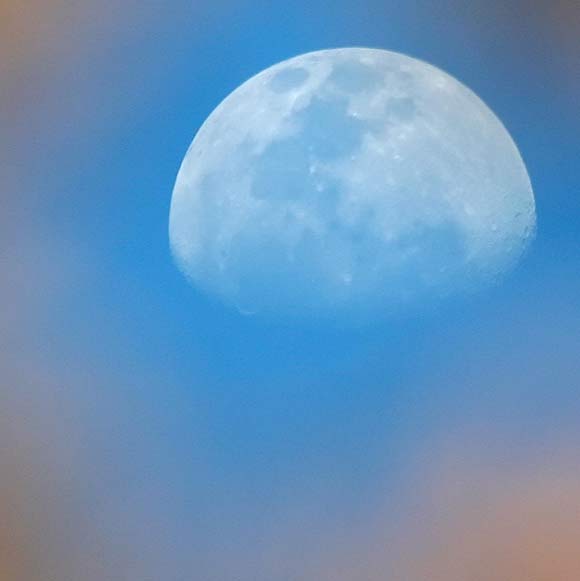
Photo Details: Rising moon framed by winter foliage, Sondela Nature Reserve, Limpopo Province, South Africa.
Camera: Canon EOS 350D; Lens: Canon 100-400 IS Zoom; Focal Length: 390mm; Shutter speed: 1/1600; Aperture: f5.6; ISO: 400
Additional Info: The photograph was taken around 4.30 in the afternoon on 3 September, a few days before full moon, while staying in a tented camp at Sondela Nature Reserve near Bella Bella in Limpopo Province.
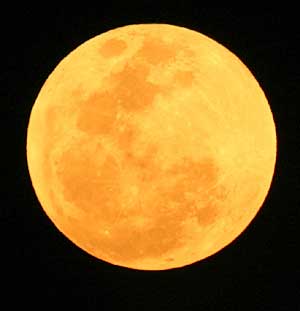
On 7 September, the full moon - a glorious bright orange orb - appeared majestically over the tree-lined horizon while we were staying on a game farm near Zeerust in the Marico Bushveld.
Sitting around our camp fire, we watched periodicaly as it marched slowly overhead. Only quite late in the evening - after a good few glasses of red wine - did I notice what looked like a small bite out of the one side - a partial eclipse was taking place. Sufficient excuse for another glass of red, savored in silence except for the crackle of the fire and the occasional call of a fierynecked nightjar. The call is said to sound like the words, "Good Lord, deliver us" - but at that stage we were sufficiently content not to want any form of deliverance.
|
Today's Picture: Tortoises Mating
September 19, 2006
|
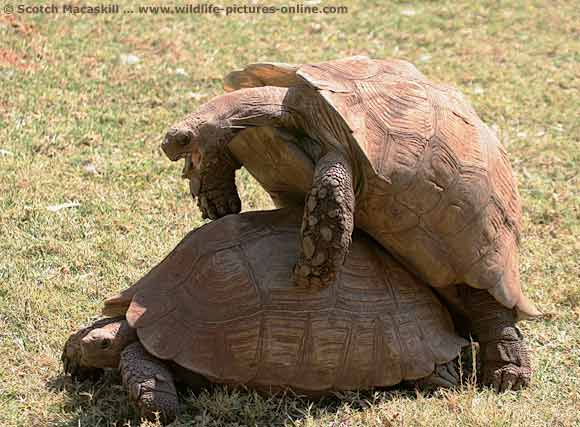
Photo Details: A pair of tortoises mating, Sondela Nature Reserve, Limpopo Province, South Africa.
Camera: Canon EOS 350D; Lens: Canon 100-400 IS Zoom; Focal Length: 100mm; Shutter speed: 1/500; Aperture: f5.6; ISO: 400
|
Today's picture: Young Serval
September 23, 2006
|
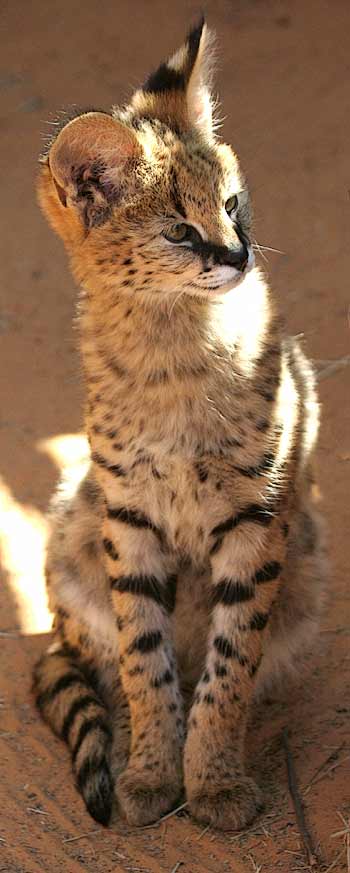 Photo Details: Young Serval (Felis serval) in dappled sunlight, Sondéla Wildlife Centre, Limpopo Province, South Africa.
Photo Details: Young Serval (Felis serval) in dappled sunlight, Sondéla Wildlife Centre, Limpopo Province, South Africa.
Camera: Canon EOS 350D; Lens: Canon 100-400 IS Zoom; Focal Length: 100mm; Shutter speed: 1/320; Aperture: f5; ISO: 400
Additional Info: This young serval has been raised at the Sondéla Wildlife Centre. Although at first glance it may be mistaken for a domestic kitten, this is a wild animal and will soon be released back into its natural environment.
Servals are good looking, elegant cats, characterized by long legs and high, upstanding ears (as can be seen in the photo) . Their color can vary from near white to a light gold, with a pattern of black bands and spots. The short tail has black rings around it, with a black tip.
Servals are nocturnal, living singly or in pairs, and live mainly on rodents, although they will also take birds, reptiles and insecst. Adults grow to about 60cm tall at the shoulder and weigh from 9kg to 11kg.
|
| |
| Back to top of page
|
|
Previous Entries
By Month
By Category
My Original Blog
2005 Entries
2004 Entries
2003 Entries
Who Am I?
Brief Bio
|

 This young samango monkey is destined to spend its life walking along and swinging from man-made ropes rather than natural branches and vines.
This young samango monkey is destined to spend its life walking along and swinging from man-made ropes rather than natural branches and vines.






 Photo Details: Young Serval (Felis serval) in dappled sunlight, Sondéla Wildlife Centre, Limpopo Province, South Africa.
Photo Details: Young Serval (Felis serval) in dappled sunlight, Sondéla Wildlife Centre, Limpopo Province, South Africa.